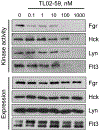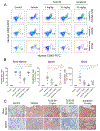Selective Inhibition of the Myeloid Src-Family Kinase Fgr Potently Suppresses AML Cell Growth in Vitro and in Vivo
- PMID: 29763550
- PMCID: PMC6130198
- DOI: 10.1021/acschembio.8b00154
Selective Inhibition of the Myeloid Src-Family Kinase Fgr Potently Suppresses AML Cell Growth in Vitro and in Vivo
Abstract
Acute myelogenous leukemia (AML) is the most common hematologic malignancy in adults and is often associated with constitutive tyrosine kinase signaling. These pathways involve the nonreceptor tyrosine kinases Fes, Syk, and the three Src-family kinases expressed in myeloid cells (Fgr, Hck, and Lyn). In this study, we report remarkable anti-AML efficacy of an N-phenylbenzamide kinase inhibitor, TL02-59. This compound potently suppressed the proliferation of bone marrow samples from 20 of 26 AML patients, with a striking correlation between inhibitor sensitivity and expression levels of the myeloid Src family kinases Fgr, Hck, and Lyn. No correlation was observed with Flt3 expression or mutational status, with the four most sensitive patient samples being wild-type for Flt3. Kinome-wide target specificity profiling coupled with in vitro kinase assays demonstrated a narrow overall target specificity profile for TL02-59, with picomolar potency against the myeloid Src-family member Fgr. In a mouse xenograft model of AML, oral administration of TL02-59 for 3 weeks at 10 mg/kg completely eliminated leukemic cells from the spleen and peripheral blood while significantly reducing bone marrow engraftment. These results identify Fgr as a previously unrecognized kinase inhibitor target in AML and TL02-59 as a possible lead compound for clinical development in AML cases that overexpress this kinase independent of Flt3 mutations.
Figures





References
Publication types
MeSH terms
Substances
Grants and funding
LinkOut - more resources
Full Text Sources
Other Literature Sources
Medical
Miscellaneous

